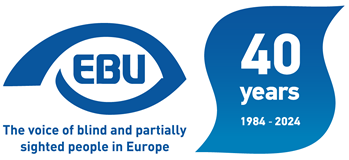By Hlynur Þór Agnarsson, Accessibility consultant
Blindrafélagið, Icelandic Association of the Visually Impaired
hlynur@blind.is
Blindrafélagið, the Icelandic Association of the Visually Impaired, has been looking into many different options in the past year regarding navigation and wayfinding solutions. This includes bluetooth beacon solutions with 3D mapping, audio beacons, tactile guidelines, NaviLens markers and other similar solutions.
When it comes to audio navigation, Iceland is far behind many other European countries. There is a great lack of legal obligations to implement audio beacons or other similar devices, for example at intersections and building entrances. Just recently, some of Iceland‘s largest municipalities started placing tactile warning studs and plates near bus stops and intersections as well as occasional guidelines outdoors.
As bad as the situation may be, we try to look ahead and focus on what we can do to change how these constructions are planned and carried out. Talking and working with government officials and others involved, we try to have an impact for the better. Even though this is a marathon, not a sprint, hopefully with time all newly built and restored structures will be accessible to everyone.
In early 2011, audio devices were installed in all buses in Iceland‘s capital region, announcing next stops for passengers on board. This was of course a great step in the right direction and as an inclusive solution, it works for everyone, not only the blind and visually impaired. In fact, general usage of public transport by blind and visually impaired people is very low compared to other countries. This may be due to the lack of quality of the public transport system, but a major factor is without a doubt a very good transport service for the blind and visually impaired, provided with collaboration of Icelandic municipalities, the Icelandic Association of the Visually Impaired and Icelandic taxi companies. This means that blind and visually impaired people in Iceland, given that they live in a municipality that has a service contract of this sort, can order a taxi in the same way as everyone else, but only pay a fee that equals 1 fare with public transport. This service has evolved over time since it was established in 1997, and now people living in many of Iceland‘s urban areas get to use this service within the Reykjavík area with support of their local municipality. This system is something we are very proud of, but it is no excuse for the lack of general accessibility for blind and visually impaired pedestrians that has been the case for many years.
As we are a nation of around 370.000 people with our own language, our small size has often been an obstacle when it comes to new technology solutions. Many of those who are using some kind of audio guidance must do so in English or one of the other major languages. But with visual impairment generally increasing as we grow older, many who are blind or visually impaired and are not confident using another language tend to get left out. The great advances in accessible technology in recent years have therefore not been available to them. There is, however, a government project currently in process which we hope will resolve this issue and encourage companies all around the world to include the Icelandic language in their own products, both to be spoken by them as well as spoken to them.

